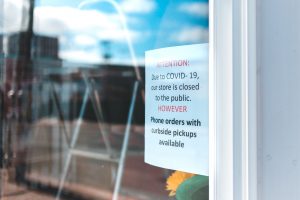Technology changes fast. Really fast. However some things in the world have seemed to always be on their own schedule when it came to getting with it. The pandemic seemed to test our ability to adapt and really catapulted the world to a whole other level of technology. Any one, or business, who wasn’t on par with the technological demands was to be left in the dust.
At first, the demand seemed to press us as individuals. If you didn’t have high speed internet or a smartphone, you couldn’t see your loved ones and keep in touch. Individuals looked for ways to push back against the constant boredom. We saw a huge uptick in the sales of streaming services, video game consoles, TVs, and personal devices.
 As the weeks crept on, companies worked overtime to get as many workers online and working remote as possible. As the reality of working remotely was looking less and less temporary, companies had to restructure their entire way of functioning. Previously, the occasional conference call or virtual meeting didn’t require much more than a pair of headphones and a built-in laptop camera. Suddenly, a high definition web camera and a noise cancelling microphone were essential to keep up with the workload and battle the commotion of other household members. Since employers couldn’t guarantee that employees were working specific hours, nor could they force them to work consecutive hours, managers had to rely on an alternative form of tracking work hours. Time tracking software became the go-to way of proving that employees were meeting hourly requirements. Other software like screensharing tools, productivity monitoring, and accountability tools were heavily utilized to keep employees on track.
As the weeks crept on, companies worked overtime to get as many workers online and working remote as possible. As the reality of working remotely was looking less and less temporary, companies had to restructure their entire way of functioning. Previously, the occasional conference call or virtual meeting didn’t require much more than a pair of headphones and a built-in laptop camera. Suddenly, a high definition web camera and a noise cancelling microphone were essential to keep up with the workload and battle the commotion of other household members. Since employers couldn’t guarantee that employees were working specific hours, nor could they force them to work consecutive hours, managers had to rely on an alternative form of tracking work hours. Time tracking software became the go-to way of proving that employees were meeting hourly requirements. Other software like screensharing tools, productivity monitoring, and accountability tools were heavily utilized to keep employees on track.
 The educational system was forced to undergo a major overhaul. Switching to online school for every student, full time, was a huge undertaking. Schools had to provide laptops and internet access to every student while also helping teachers get set up to provide an effective learning environment for them. Even more behind the scenes, schools had to update their websites, provide platforms, and make sure their servers could handle the massive increase.
The educational system was forced to undergo a major overhaul. Switching to online school for every student, full time, was a huge undertaking. Schools had to provide laptops and internet access to every student while also helping teachers get set up to provide an effective learning environment for them. Even more behind the scenes, schools had to update their websites, provide platforms, and make sure their servers could handle the massive increase.
 Local businesses like retail shops and restaurants quickly figured out that E-commerce and curbside pickup were the best way to keep customers shopping and prevent themselves from getting even farther behind in keeping up with overhead costs. More than just website renovations, businesses had to offer online shopping options and systems of communicating with customers without contact. For the first time ever, cash was not accepted and businesses needed to adapt quickly. Touchless payment options were a must and required new devices that could support Tap, ApplePay, GooglePay, etc. A structure for curbside pickup looked different for every business. Some businesses needed to upgrade their phones to support multiple lines to handle the increase in calls and voicemails, while some opted for a digital doorbell system to improve customer communication. Restaurants had to streamline their process for receiving and fulfilling online takeout orders. Technology that could keep everyone socially distanced without sacrificing communication was crucial. Some businesses added a delivery option to keep sales up. This required a reliable form of GPS to be able to keep up with managing delivery routes. Making all of these changes happen seamlessly in a record timeframe has been impressive!
Local businesses like retail shops and restaurants quickly figured out that E-commerce and curbside pickup were the best way to keep customers shopping and prevent themselves from getting even farther behind in keeping up with overhead costs. More than just website renovations, businesses had to offer online shopping options and systems of communicating with customers without contact. For the first time ever, cash was not accepted and businesses needed to adapt quickly. Touchless payment options were a must and required new devices that could support Tap, ApplePay, GooglePay, etc. A structure for curbside pickup looked different for every business. Some businesses needed to upgrade their phones to support multiple lines to handle the increase in calls and voicemails, while some opted for a digital doorbell system to improve customer communication. Restaurants had to streamline their process for receiving and fulfilling online takeout orders. Technology that could keep everyone socially distanced without sacrificing communication was crucial. Some businesses added a delivery option to keep sales up. This required a reliable form of GPS to be able to keep up with managing delivery routes. Making all of these changes happen seamlessly in a record timeframe has been impressive!
Unfortunately, not everyone was able to translate their work to meet the new online demand. For jobs that relied on in-person interaction and a physical appearance, workers were left without an alternative. Thanks to government assistance, Unemployment Benefits became available to those whose jobs were forced to close down. This department had to renovate their entire process to accommodate the up to 2,871% increase of claims. Even after an increase in server capacity, the site still couldn’t keep up with the amount of traffic for some time.
When we take a step back and see how much the world upgraded in less than one year, it’s staggering. It propelled us ahead to a point where we can thank technology for making a difficult time actually manageable. The good news is we will most likely benefit from these changes for quite some time.
